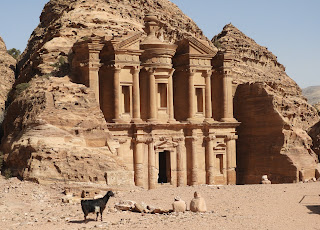 |
| The Monastery, Petra |
When we first visited Petra with our kids nearly 40 years
ago, Bedouin families were still living in its caves. The next year, the Jordanian government
kicked them all out, moving them to a village above the valley, in order to
turn Petra into a “real” tourist site.
It was phenomenal then, when our kids were able to play soccer with
local Bedouin boys inside one of the huge cave tombs. Today, it is no less wonderful, just filled
with Bedouin offering rides on their camels and donkeys instead of living in
the caves. view of Wadi Musa (Petra) from above
The valley is one of the most spectacular ancient cities in
the world. First, the rock into which
the tombs and temples have been carved is multi-colored and gorgeous. Petra's colorful rock formations
Second, one of the most stunning sights on earth is
emerging from the narrow Siq, a deep rock chasm with towering cliffs, ranging
from 10 to 40 feet wide and ¾ mile long, to see the famous Treasury
building, what everyone visits Petra to see.
 |
| the beautiful Treasury |
But, there is so much more—the Nabataean stone architecture and tombs, Roman ruins, Byzantine mosaics, not to mention the natural beauty of Wadi Musa (Valley of Moses), the canyon of Petra, occupied for 12,000 years.
All along the valley, tombs have been carved into the sandstone. You can walk the length of the valley to a restaurant at the end and then climb another mile to the Monastery, a third century BC Nabataean tomb surrounded by huge black rock mountains and many vendors. If you don’t want to climb the stairs cut into the rocks, you can take a donkey ride, which one of our group decided to do. Despite her qualms, her donkey and guide hauled her safely up the steep trail so she could see not just the Monastery, but the gorgeous terrain all around. If you walk from the entrance to a viewpoint past the Monastery and back, it is 10 to 11 miles, and a wonderful hike.
 |
| mosaic floor in Byzantine church |



























